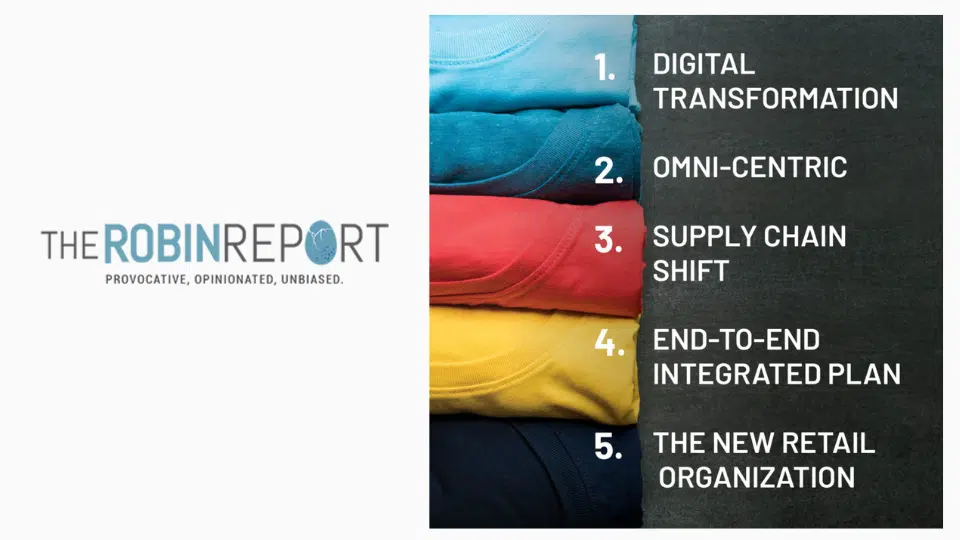By Jon Beck

Over the last three years retailers and brands were faced with both opportunistic initiatives and post-pandemic obstacles. The industry unilaterally and almost instantaneously became aware of how the overall business model was changing. Consumer behaviors and demands have forced a re-examination of how retailers and brands operate, creating a fundamental shift from product to consumer centricity. As a result, retailers are currently focused on evolving their people, processes and platforms.
Columbus Consulting has a special vantage point because we see firsthand what retailers are looking for and then we evaluate their needs and find the right solutions that drive tangible and scalable results.
This retail model re-evaluation has resulted in a two-fold approach around systems and workflow integration and the overall organizational foundation, encouraging retailers to hone a laser focus on evolving their business. We can say this with confidence, as we had over 250 active projects across 110 clients in 2022. Columbus Consulting has a special vantage point because we see firsthand what retailers are looking for and then we evaluate their needs and find the right solutions that drive tangible and scalable results.
What’s Commanding the C-Suite Conversation?
Based on our extensive experience with retail leaders, we have used that expertise to reveal what the industry is focused on for 2023, based on 2022 experiences. There are five key priorities:
- Digital transformation across the organization
- Omni-centric processes and systems enablement
- Supply chain shift from macro to micro
- End-to-end integrated planning
- The new retail organization
1/ Digital Transformation
When we talk about digital transformation, we are not strictly speaking about the technology and its capabilities. We focus on how retailers are transitioning their business operations from physical touchpoints to digital/virtual interactions. This shift requires technology and integration but, more importantly, requires organizations to fundamentally adapt to new ways of working. And that involves informing, training, and getting buy-in from the workforce. Digital transformation can get derailed without people supporting the process. This transformation can take place in any function at any level. For instance, in the product development stage of lifecycle management, digital transformation has been inserted into 3D designs, virtual fittings, augmented reality sampling and remote team alignment. Once enabled, transformation will result in faster, cheaper, better processes that yield cost savings, margin improvement and even speed to market.
2/ Omni-Centrism
While we have all been barraged by industry lingo with multi-channel, digital commerce, omnichannel and consumer-centric terminology, the true conversation in 2023 will be about the fundamental pivot from product to consumer as the driver of business process. Here’s the traditional sequence: Workflow starts with an idea for a product improvement. The product is then designed, sourced, priced, sold. Everything around this pathway is driven from the inside out. Today, the process is flipped, driven from the outside in. Consumer and market demand is determining what, where, when and even how much of anything should be delivered. This pivot has impacted retailers based on their organizational maturity curve. In simple terms, legacy retailers are now setting up processes and systems and redefining roles and talent needs around the customer, not the product. They are no longer separating digital from physical and are streamlining transactions and consumer experiences. This transformation is beyond cross channel services like BOPIS; it is an optimization that is invisible to the customer, shifting from linear to circularity across functions to be agile and more predictive.
3/ The Reinvented Supply Chain
The recent supply chain conversation was not just a temporary media moment. The supply chain has always been at the core of retail, but it has shifted to the need for a more holistic strategy. Retailers and brands conventionally had siloed teams sourcing materials, working with factories, merchandising the products, determining the inventory levels, managing the shipping, and receiving and overseeing the sales channels. It took a global pandemic to unveil the vulnerability of those processes and reveal the complete lack of visibility of what was actually happening along the chain. The fact that the supply chain literally and metaphorically broke down should not have been a surprise. What was a surprise was that retailers didn’t know they had a problem until they had the problem. When scheduled goods did not show up at the docks or at the warehouses or, ultimately, at the stores, it took the industry off guard. Why? Because operators did not have a micro view of the steps throughout the process and were unable to be nimble and quickly change factories, shift materials, or build into available goods.
4/ End-to-End Integrated Planning
When retailers speak about planning, they often reference the term as it relates to their specific business discipline. Merchants are looking at the product lifecycle, inventory and forecasting; finance is looking at the fiscal calendar, profits, quarterly reporting needs; marketing is looking at campaign flights, omni-channel product presentation and performance KPIs. These views have traditionally been done in hindsight, with a look to LY or YOY trends to determine a forward view. Much like everything else post-covid, however, retailers quickly learned that historical views were not sustainable and that historical methodologies could not account for unforeseen variables. Savvy retailers and brands immediately pivoted to more predictive and exception-based models to determine consumer demand and business opportunities. This shift required a re-establishment of the business process, calendarization and cross-functional alignment across finance, marketing, merchandising, supply chain, operations and planning. This is now resulting in teams working collectively with one plan, one view of the calendar, one view of the data and unified goals regardless of the business area within an organization.
5/ The New Retail Organization
Perhaps the most critical trend in 2023 will be the rebuilding and reorganizing the retail workforce. This reinvention has been triggered by digital transformation, remote labor, the necessity for new skills, and the productivity of leaner more analytically-driven teams. Many businesses are relying on AI/ML to drive their transformative initiatives, but AI alone cannot deliver sustainable and scalable results. The real transformation needs to be built on an evolved organizational foundation. Roles and responsibilities, cross-functional and channel process integration, and new team members blended with experienced talent are all key ingredients to the new retail recipe for success.
It’s All About Continuous Evolution
While there are always seeds being planted for long-term industry reinvention, more often than not, systematic evolution is the key to improvement. At Columbus Consulting, we predict the industry will reevaluate (more likely overhaul) their internal processes, systems, resources and data. Retailers and brands will embrace new ways to operate, collaborate and evolve their digital integration, fully support consumer-centric/omni-shopping behaviors, refine supply chain touch points, build end-to-end planning models, and look to their new retail organization to retain and acquire the right talent for the future.
* Republished with permission from The Robin Report.

